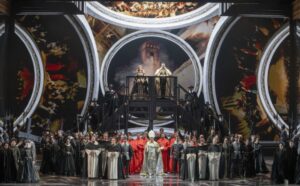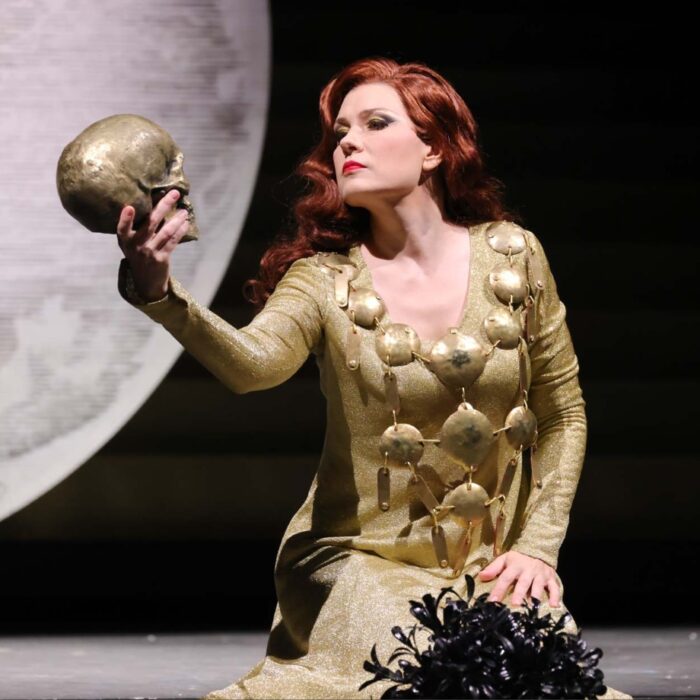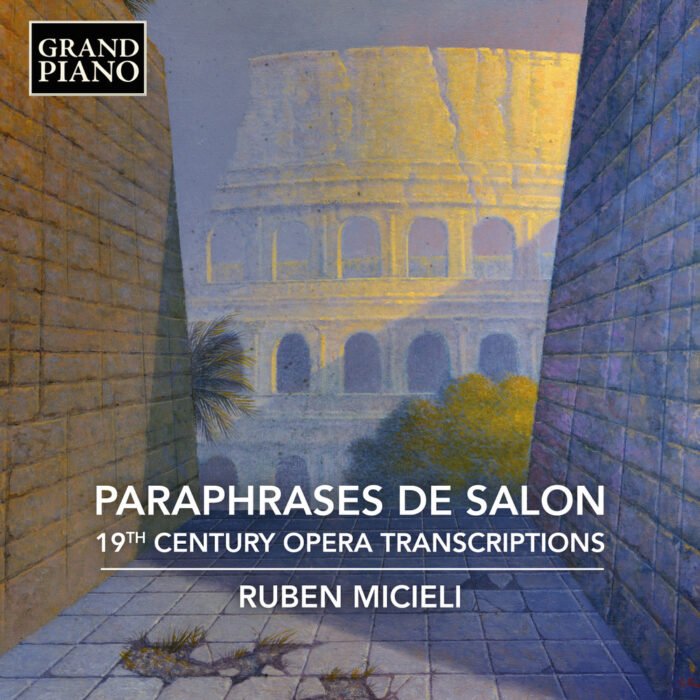
Opéra de Monte-Carlo 2023 Review: Don Carlo
By Robert Adelson & Jacqueline LetzterCredit: © OMC-Marco Borrelli
On Sunday November 26th, the Opéra de Monte-Carlo gave the final performance of its first staged opera of the season, a new production of Verdi’s “Don Carlo” in the four-act Italian version of 1884.
The staging was entrusted to the Turin-based Davide Livermore, scenographer Giò Forma, costume designer Sofia Tasmagambetova and Video designer D-WOK. Although Livermore and Tasmagambetova retained the original setting and costumes of sixteenth-century Spain, the production was anything but conventional due to the extent and the sophistication of the video technology employed.
Impressive But Excessive Video Decors
The background decors consisted of a moving and changing video projection, while the stage itself was built around a large and often rotating plateau that served as a conveyer belt for the singers and various pieces of furniture and other props.
Many of the video effects were stunning in their beauty and complexity. In some scenes the background was a sky filled with dark churning clouds; in others, one saw a Correggio fresco come to life or a room in the Escorial palace expertly recreated in three-dimensions. In a four-hour long opera, however, one soon tired of the incessant projections, especially since some were rather cliché, such as the rose petals for the chorus of Eboli’s ladies in waiting or the lightning bolts that appeared every time disaster loomed or a character grew angry. In the end, the video projections gave the impression of elaborate computer screen savers, conceived for an audience with a short attention span.
Curiously, these highly dynamic decors were paired with an extraordinarily stiff approach to acting. This was apparent right from the opening notes of the Act one prelude, when Carlo first appeared on stage, looking troubled. As if on cue, at the first dissonant chord in the horns, he fell to his knees holding his hands over his eyes. This stilted acting detracted from what would otherwise be important moments, such as the famous duo, “Dio, che nell’alma infondere,” between Carlo and Rodrigo. Although the characters are ostensibly vowing eternal friendship, Sergey Skorokhodov as Carlo and Artur Rucinski as Rodrigo rarely looked at each other, instead staring straight out ahead with their eyes glued on the baton of conductor Massimo Zanetti. Admittedly this duo is difficult to coordinate between the singers, who must perfectly time the beginning of their rapid triplets after each held note, to say nothing of the traditional rubato on the high note of each phrase. Usually, singers can accomplish this while looking at each other, thanks to video monitors of the conductor positioned in the wings, but in this production the practice of singing while facing out at the audience was the norm, not the exception.
Carlo is a character whose psychological state is incessantly changing, but Skorokhodov’s acting did not show this convincingly. For example, in Act two when Rodrigo tells Carlo to entrust him with any incriminating papers he might be carrying, Carlo at first hesitates, doubting whether he should trust Rodrigo, but then he remembers their friendship, and there follows a brief reprise of their duo ‘Dio, che nell’alma infondere.’ This is a short but complex exchange where Carlo must reveal that he is unsure of his allegiance, but Skorokhodov failed to show any of these shifting emotions, leaving the scene regrettably flat.
Disappointing Cancellations
The Opéra de Monte-Carlo has been plagued by several high-profile cancellations ever since Cecilia Bartoli’s arrival as director in the beginning of the year.
First, Jonas Kaufmann withdrew from a February production of “Andrea Chénier,” and both bass Ildar Abdrazakov and conductor Daniel Barenboim pulled out of a recent Verdi Requiem (following Barenboim’s cancellation of a piano recital organized by the opera house last season). These cancellations for health reasons are common to all opera companies, but some of the most eagerly awaited performers have withdrawn for unspecified “personal reasons.”
This was the case in March, when Plácido Domingo, pulled out of a production of “La Traviata,” where he was to sing the role of Giorgio Germont. This was also the reason given for the recent cancellation by Vittorio Grigolo, who was to sing the title role in “Don Carlo.” Grigolo’s withdrawal was announced on November 14th for a production to open on November 22nd, but apparently his “personal reasons” did not prevent him from immediately flying to Dubai to sing at the Dubai Opera Ball on November 18th.
An Uneven Cast
Unfortunately, Grigolo’s replacement Sergey Skorokhodov did not have a strong enough voice for the role. Throughout the performance he suffered by comparison with other cast members, a problem one noticed from the very opening of the opera when he followed the sonorous bass of Giorgi Manoshvili in the role of the Monk.
This vocal mismatch was not a problem, however, when Skorokhodov’s Carlo shared the stage with Elisabetta, sung by soprano Joyce El-Khoury. Like Skorokhodov, El-Khoury struggled to achieve a satisfactorily resonant tone in the large hall. In her “Non pianger, mia compagna” aria from Act one, her voice came across as thin when singing piano and strident when singing forte. In her Act four aria “Tu che le vanità,” set in front of a breathtakingly beautiful video backdrop of the milky way, her vocal delivery was hampered by a lack of core in the extreme low register.
Some of the singers cast in the other male leads compensated for the absence of a strong Carlo. Rodrigo, sung by the Polish baritone Artur Rucinski, was beautifully consistent throughout the performance, spinning long legato phrases with a tone well-suited to the hall. Ildar Abdrazakov, in the role of Fillipo, was a commanding presence, in both his singing and acting, overshadowing Alexey Tikhomirov’s interpretation of the Grand Inquisitor.
Another of the strongest singers was the Franco-Armenian mezzo-soprano Varduhi Abrahamyan in the role of Eboli. Her Veil Song, “Nel giardin del bello,” showcased her dusky low register, particularly in the sensuous chromatically descending lines.
Given the uneven cast, it was refreshing to hear that some of the ensembles were nevertheless effective. The trio for Elisabetta, Rodrigo and Carlo at the end of Act two, for example, came off well, in part because the scoring of Carlo’s part allowed Skorokhodov’s to project over the others.
A Stirring Orchestral Contribution
The extended cello solo at the opening of Act four was superbly played by Delphine Perrone, and Mathilde Rampelberg’s English horn solos added poignancy to Elisabetta’s aria “Non pianger, mia compagna” in Act one. Conductor Massimo Zanetti was highly effective in bringing out the more passionate moments of Verdi’s score, particularly in the introduction to Elisabetta’s Act four aria “Tu che le vanità conoscenti del mondo,” the only moment in the entire performance when the orchestra played with the curtain drawn and with no videos to distract one’s attention from the music. Similarly, Zanetti brought out the pathos in the Act four duo between Carlo and Elisabetta by emphasizing the mournful accents in the violas and cellos. However, he seemed less interested than other conductors in wallowing in the lugubrious moments of the score. For example, in the second scene of Act two, where the monks escort the heretics to the stake, the funeral march in the low woodwinds sounded more nimble than menacing. On the other hand, in the music for the Inquisitor, Zanetti brought to the fore the contrabassoon and double bass, lending an eerie quality to the scene.
Unfortunately, the efforts of the musicians in the Orchestre philharmonique de Monte-Carlo were somewhat spoiled by the incomprehensible decision to “enhance” their sound through amplification. It’s true that this orchestra has the luxury of playing regularly in the Salle Garnier (524 seats), with its incomparable acoustics and tiny size compared to the cavernous Salle des Princes at the Grimaldi Forum (1800 seats) where “Don Carlo” was presented. However, amplification of the orchestra is usually not necessary, even in very large halls such as New York’s Metropolitan Opera (3800 seats). Opera houses that typically use discreet microphones do so for singers, not for the orchestra. The result of this decision to give the instrumentalists a little boost was dubious, as there were moments when they were too loud for both Skorokhodov and El-Khoury. Paradoxically, this amplification of the orchestra was most apparent in some of the softest orchestral passages, and in the reading of the assignation letter, which was so loud that for a moment one could have mistaken it for an admonishment to turn off cell phones delivered through a public address system.
Operawire will cover the next collaboration between the Opéra de Monte-Carlo and the production team of Livermore, Giò Forma, and D-WOK a new production of Handel’s “Giulio Cesare in Egitto” in January 2024.



